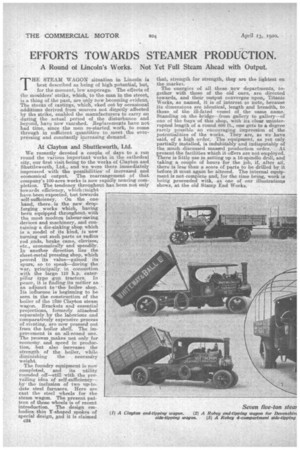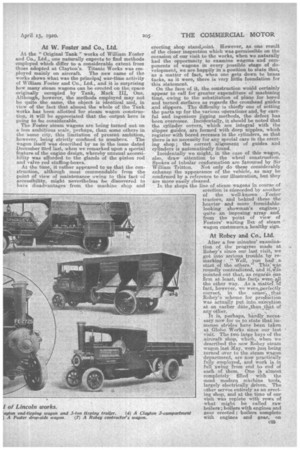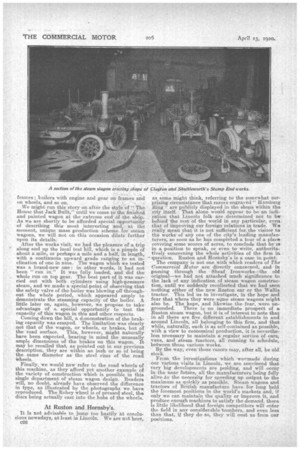EFFORTS TOWARDS STEAMER PRODUCTION.
Page 10

Page 11

Page 12

If you've noticed an error in this article please click here to report it so we can fix it.
A Round of Lincoln's Works. Not Yet Full Steam Ahead with Output.
THE STEAM WAGON situation in Lincoln is best described as being of high potential, but, for the moment, low amperage. The effects of the moulders' strike, which, to the man in the street, is athing of the past, are only now becoming evident. The stocks of Castings, which, eked out by occasional additions derived from sources not directly affected by the strike, enabled the manufacturers to carry on during the actual period of the disturbance and beyond, have now vanished. Replacements have not had time, since the men re-started, work, to come through in sufficient quantities to meet the everpressing and constantly increasing demand.
At Clayton and Shuttleworth, Ltd.
• separately by the laborious and comparatively expensive process of riveting, are now pressed out from the boiler shell. The impravement is an all-round one. The process makes not only for economy and speed in production, but also increases the strength of the boiler, while diminishing the necessary weight.
The foundry equipment is now completed, and its utility rounded off—still with the pre vailing idea of self-sufficiency— by the inclusion of two up-to date steel furnaces. Kern are cast the steel wheel; for the steam wagon. The present pat
tern of those wheels as of recent introduction. The design embodies thin Y-shaped spokes of special design, And it is claimed
o2A that, strength for strength, they are the lightest on the market.
The energies of all these new departments, together with those of the old ones, arc directed towards, and their output converges upon, Titanic Works, go named, it is of interest -to note, because its dimensions are identical, length and breadth, to those of the ill-fated vessel of the same name. Standing on the bridge—from gallery to gallery—of one of the bays of this shop, with its clear uninterrupted length of a round NO IL, one gets to a degree rarely possible an encouraging impression of the potentialities of the works. They are, as we have said, of a high order. The equipment, as yet only partially installed, is indubitably and indisputably of the much discussed massed production order. At present the facilities which it offers are not employed. There is little use in setting up a 16-spindle drill, and taking a. couple of hours for the job, if, after ail, there is less than a. score of parts to be drilled by it before it must again be altered. The internal equipment is not complete and, for the time being, work is being proceeded with, as. one of our illustrations shows, at the old Stamp End Works.
At W. Foster and Co., Ltd.
At the "Original Tank works of William Foster and Co. Ltd., one naturally expects to find methods employed which differ to a considerable extent front those adopted at Clayton's. Titanic Works was employed mainly on aircraft. The new name of the works shows what was the principal war-time activity of William Foster and Co., Ltd., and it is surprising how many steam wagons can be erected on the, space originally occupied by Tank, Mark III, One. Although, however, the methods employed may not be quite the same, the object is identical and, in view of the fact that almost the whole of the Tank works has been allotted for steam wagon construction, it will be appreciated that the output here is going to be considerable.
The Foster steam wagons are being turned out on a less ambitious scale, perhaps, than some others in the 'same city, this limitation of present ambition, however, being strictly confined to numbers. The wagon itself was described by us in the issue dated December 23rd last, when we remarked upon a special feature of the engine design, whereby unusual accessibility was afforded to the glands of the piston rod and valve rod stuffing-boxes.
At the time, it rather appeared to us that the con-. struction, although most commendable from the point of view of maintenance owing to this fact of accessibility, might nevertheless be discovered to have disadvantages from the machine shop and erecting shop standpoint. However, as. one result of the closer inspection which was permissible on the occasion of our visit to the works, when we naturally had the opportunity to examine wagons and components of wagons in every possible stage of development, we are happily in a position to state that, as a matter of fact, wheo one gets down to brass tacks, as it were, there is very little foundation for this statement.
On the face of it, the construction would certainly appear to call for greater expenditure of machining time, owing to the substitution of plane for bored and turned surfaces as regards the crosshead guides and slippers The difficulty is chiefly one of setting the parts up for the various operations and, by careful and ingenious jigging methods, the defect has been. overcome. Incidentally, it should be noted that the cylinder covers, • which are integral with the slipper guides, are formed with deep nipples, which register -with bored recesses in the cylinders, so that there is no necessity for any special care in the erecting shop the correct alignment of guides and cylinders is automatically found. Incidentally we might, in the case of this wagon, also, draw attention to the wheel construction. Spokes of tubular conformation are favoured by Sir William Tritton. Not only do these considerably enhance the appearance of the vehicle, as may be confirmed by a reference to our illustration, but they are more easily cleaned. In the shops the line of steam wagons in course of erection is succeeded by another of the well-known .. Foster tractors, and behind these the heavier and more formidablelooking showman's engines; quite an imposing array and. from the point of view of Fosters' waiting list of steam wagon customers,a healthy sign.
At Robey and -Co., Ltd.
After a few minutes' examination of the progress made at Robey's since our last visit, we got into serious trouble by remarking : "Well, you had , start of the others." . ThiS'Ny.-As roundly contradicted, and it,was pointed out that, as regardi One firm at least, the facts. wereall the other way. As a niattet:Of fact, however, we weradderfeCtly correct, in the Eenae..,:... that Robey's -scheme for production was actually put into eieetititin at an earlier date than ,that of
any other. .
It is, perhaps, hardly necessary now for us to state that immense strides have been taken at 'Globe Works since our last visit. The two large bays of the aircraft shop, which, when we described the new Robey steam wagon last May, were just being turned over to the steam wagon department, are naw practically fully employed, and work is in full 'swing from end to end of each of them. One is almost completely filled with the most modern machine tools, largely electrically driven. The other serves entirely as an erecting shop, and at the time of our visit was replete with rows of what might be called raw boilers ; boilers with engines and gear erected ; boilers complete with engines and gear, on frames ; 'boilers with engine and gear on frames and on wheels, and so on.
We might run this story on.after the style of " The House that Jack Built," until we come to the finished and painted wagon at the extreme end of the shop. As we are shortly to be afforded special opportunity of describing this most interesting and, at the moment, unique mass production scheme for steam wagons, we ' will not on this occasion dilate further upon its details:
After the works visit, we had the pleasure of a trip along and up the local test hill, which is a pimple of about a mile, or perhaps a mile and a, half, in length, with a continuous upward grade ranging to an inclination of one in nine. The wagon which we tested was a brand-new one : in other words, it had not been "run in." It was fully, loaded, and did the whole run on top gear. The best part of it was carried out with both cylinders • using high-pressure steam, and we made a special point of observing that the safety valve of the boiler was blowing off throughout the whole period, which appeared amply to demonstrate the steaming capacity of the boiler. A little later on, again,i however, we propose to take advantage of a special opportunity to test the capacity of this wagon in this and other respects.
Coming down the hill, -a demonstration of the braking* capacity was essayed. The limitation was clearly not that of the wagon, or wheels, or brakes, but of the road surface. This, however, might naturally have been expected, bearing in mind the unusualLy ample dimensions of the brakes on this wagon.It may be recalled that, as pointed out in our previous description, they are within an inch or so of being the same diameter as the steel rims of the road ;wheels.
Finally, we would now refer to the road wheels of this machine, as they afford yet another example of the variety of construction which is possible in this single department of steam wagon design. Readers will, no doubt, already have observed the difference in type, as illustrated by the photographs we have reproduced. The Robey wheel is of pressed steel, the discs being actually cast into the hubs of the wheels.
At Ruston and Hornsby's.
It is not advisable to jump too hastily at conclusions nowadays, at least in Lincoln. We are not here, 026
as some might think, referring to the somewhat surprising circimistance that razor s engraved" Hamburg Ring are publicly displayed in the shops within the city itself. That alone would appear to be an indication that Lincoln folk are determined not to be behind the rest of the world in any particular, even that of improving our foreign relations in trade. We really mean that it is not sufficient for, the visitor to the works of any one of the city's leading manufacturers, so soon as he has completed a tour of a place covering some scores of acres, to conclude that he is in a position to speak, or even to write, authoritatively concerning the whole activities of the firm in question. Ruston and Hornsby's is a case in point. The company is not one with which readers of The Commercial 'Motor are directly concerned, and in passing through the Sheaf Ironworks—the old original—we had not attached much significance to the lack of any indication of steam wagon construction, until wesuddenly recollected that we had seen nothing either of the new Ruston car or the Wallis tractor. This led us to investigate, in the hope and fear that where they were seine steam wagons might also be. The hope, and likewise the fear, were ungrounded. There is no immediate prospect of a. Ruston steam wagon, but it is of interest to note that in all there are five different establishments in and around Lincoln, all belonging to this firm, and that while, naturally, each is as self-contained as possible, with a view to economical production, it is nevertheless necessary to maintain a regular service of ears, vans, and OR= tractors, all running to schedule, between these various works.
By the way, even those razors may, after all, be old stock.
From the investigations which •wetnnade during our various visits in Lincoln, we are convinced that very big developments are pending, and will occur in the near future, all the manufacturers being fully* alive to the necessity for speeding up output to the maximum as quickly as possible. Steam wagons and tractors of British manufacture have for long held the foremost positions in the world's markets and, if only we can maintain the quality or improve it, and produce enough machines to satisfy the demand, there is little likelihood that foreign competitors will enter the field in any eonsiderable 'numbers, and even less than that, if they do so, they will oust us from our positions.


























